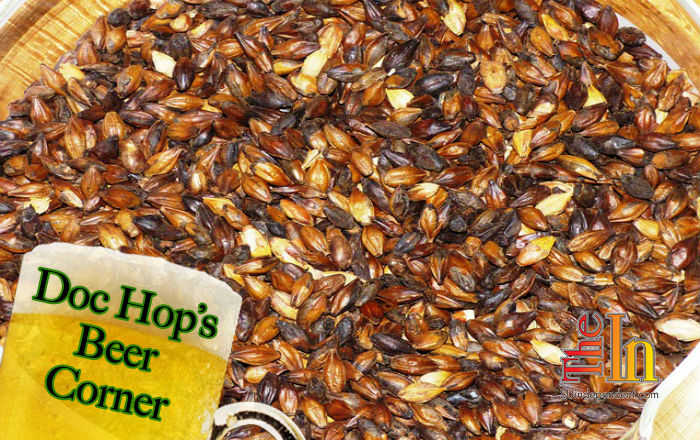 Written by Jeremy Hopkin
Written by Jeremy Hopkin“This is grain, which any fool can eat, but for which the Lord intended a more divine means of consumption… Beer!” — Friar Tuck, in the film Robin Hood, Prince of Thieves
Malty goodness
So having previously discussed the lynchpin in fermentation (yeast) with our last column and beer tasting prior to that, it’s now time to turn our attention to the main sidekick – grains!
As we have discussed previously, grains are not necessarily ALWAYS a part of fermented beverages, and while some of these beverages could loosely be considered beer, talking about beer without talking about grains is like cooking a pizza without cheese. I guess you could. But why? Grains form the backbone of all beers, and depending on who you ask you can’t even classify a drink as beer unless it contains grains. Grains provide the fuel for the yeast that eventually provides us with our intoxicating ethanol.
From both a current and historical standpoint the main component in beer is malted barley. Barley is a grain that had been cultivated for centuries along side other grains like wheat, rye and oats. Its preeminence in the world of beer has to do with some unique properties it has that make it both difficult to use for making bread and easy to use for making beer.
The outer hull of barley is tough in comparison to other grains and maintains its shape even after heating, whereas the hull of wheat is softer and more malleable. This makes it an ideal grain for creating a natural filter bed for creating wort (unfermented beer) without getting lots of sludge and pieces of grain in it. The shell of wheat and other grains tends to clump and create a poor filter. The starches in barley are also a bit more difficult to convert into sugars than wheat during the baking and milling process, making it less than ideal for making bread.
Had it not been for this nice hard shell, we very well might be eating barley bread routinely and drinking mostly wheat beer. It is interesting to note that the Reinheitsgebot issued in Germany probably had very little to do with purity in beer, but rather restricting the use of wheat for the making of beer. Germany was having a wheat blight at the time and shortages of bread were common.
It’s a telling story of the ancient beer loving German that they would rather use wheat to make beer and be hungry for bread than dare go thirsty for beer. Hmmm, dry crackers or nice frothy Hefewiezen? Cant’ say I blame them!
Having a good shell for creating a filter is not the only special attribute of barley. When we talk about barley in brewing we are almost always talking about malted barley. If you were to harvest barley from the field and dry it, grind it and try to use it for making beer, you would end up with a gooey, poorly fermented beer resembling pig slop.
Malting a grain is a complex process that converts poorly accessible starches inside the grain into sugars that yeast can eat (and that taste better!). Chewing on unmalted barley would be like chewing a piece of dirty grass, whereas chewing on malted barley would be akin to crunching on a nice sweet grape nut (cereal).
Malting a grain starts by steeping it in water. This starts the process of germination, where the grain begins the process of enzymatically converting starches into sugars to feed the impending sprout of grass. So it thinks! Then comes the human to thwart this procreative process as we damn well please. This process is halted before the seed can sprout by heating and drying the grain. The sugars and enzymes are essentially halted in time – allowing us to harvest them.
This brings up another unique quality of barley that is important for brewing. Compared to other grains, the concentration of those enzymes that convert starch to sugar is very high. This is called diastatic power.
Barley has enough diastatic power to make up for the relative lack of these enzymes in oats, rice, wheat and other grains you might put in your beer. So it provides duel properties of a strong filtering husk and is also the enzymatic workhorse of unfermented beer.
Once the barley is malted, it is roasted to different specifications (amount of water, temperature) to create different flavors of malted barley. There are literally hundreds of styles of malt that provide distinct flavors that range from bread and biscuit flavor to coffee, caramel and nut flavors.
Once the brewer has decided on how she wants her beer to taste, she can combine these malts to achieve that goal. On a very basic level, the malted barley is put into hot water and allowed to steep in the water just like you would a cup of tea. After a period of time, the resulting slurry is turned into a nice golden brown liquid by filtering out the grain. Presto- you have your wort! This is your precious beer baby, almost ready to be matured by fermentation into a grown up, fully drinkable beer.
Depending on the type of beer you are drinking, the malted barley or grains might be a subtle counterpoint or balance to hops, yeast and other additives. In a sense it could be considered the canvas on which other flavors are painted for those styles of beer. In other styles the malt will dominate the flavor profile. Beers styles like brown ales, nut ales, porters and stouts are where these malt flavors really shine.
We have already discussed barley, but there are many other grains that can be added to beer to change the taste profile. Although this list of grains is in no way exhaustive, the grains listed below are some of the more commonly used in brewing. Here is a short description of what it imparts:
CORN: Neutral sweetness. Mostly used to lighten body and color
OATS: Kind of the opposite of corn. Oats create a creamy, full-bodied brew that imparts a nice smoothness – perfect in stouts. Taste is usually neutral, but if the oat levels are high enough it will taste – like oatmeal!
RICE: Like corn, used mostly to lighten body and color, allowing clean crisp flavors from hops or other additives to predominate.
RYE: Used at high enough levels, it adds some spiciness and complexity to a base barley blend. Contributes to body just about like barley.
WHEAT: Ounce for ounce, wheat has a much higher protein content then other grains. This help with making a nice foamy head that stays put for the entire pint and can also impart haziness to beer. Expect bread flavors. At high enough levels it can even be a little tart.
So with grains on the brain – I have chosen the next beer for our group sampling. Its flavor profile highlights malted barley. Look for caramel, bready and even some mild nut flavors. It is Big Sky Brewing’s Moose Drool Brown Ale. Grab a six-pack, get it cool and prepare to drink your bread!
Cheers,
Doc Hop
 Jeremy Hopkin grew up in the heart of happy valley (Orem, UT). He received his undergraduate degree in zoology, got his M.D. degree from University of Utah, and did his residency in radiology at Dartmouth including a fellowship in neuroradiology. He is currently employed locally as a diagnostic radiologist and also treats varicose vein disease at Red Sands Vein and Laser Institute. He gives training and nutritional advice to athletes of all ages, shapes and sizes at Crossfit St. George and loves to help people attain their health goals. He is fascinated with science and is a tinkerer in all things fermentation. He’s been a home brewer for 7 years and is a beer lover for life! For questions or comments, Jeremy can be reached at [email protected]
Jeremy Hopkin grew up in the heart of happy valley (Orem, UT). He received his undergraduate degree in zoology, got his M.D. degree from University of Utah, and did his residency in radiology at Dartmouth including a fellowship in neuroradiology. He is currently employed locally as a diagnostic radiologist and also treats varicose vein disease at Red Sands Vein and Laser Institute. He gives training and nutritional advice to athletes of all ages, shapes and sizes at Crossfit St. George and loves to help people attain their health goals. He is fascinated with science and is a tinkerer in all things fermentation. He’s been a home brewer for 7 years and is a beer lover for life! For questions or comments, Jeremy can be reached at [email protected]



